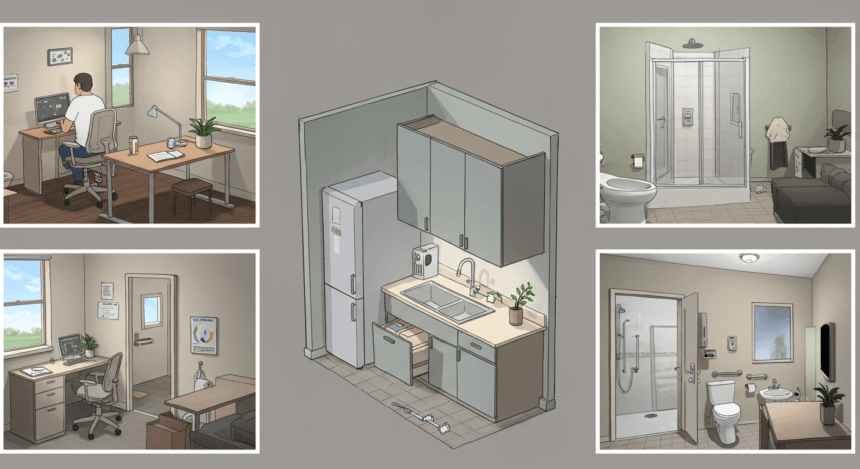Creating a home to aid in management of chronic diseases is less a matter of being comfortable and more an essential element of health and independence and adding to overall well-being. An estimated 129 million Americans experience at least one significant chronic disease, and there are design concepts that can add to the betterment of every day.
These accommodations can range from installing grab bars in the bathroom and slip-resistant flooring, to lighting changes and reducing clutter to prevent accidents. This can be easier than working with a home health agency (which we talked about before). These adjustments aren’t luxuries—they’re necessities for millions of individuals who cope with fatigue, mobility, or pain on a daily basis.
In fact, as of 2018, almost 27% of American adults lived with two or more chronic conditions, making the need for supportive and accessible environments even greater. Studies show that older adults in particularly large numbers are likely to benefit from home adaptations, with 6.8 million households finding it hard to use or get around their homes. Small design changes—such as wider doors for wheelchair accessibility or rearranged kitchens for easier access—can allow individuals to stay active and engaged in their homes. When homes are built for health, they are centers of recovery, not barriers to well-being.
Being chronically ill is a full-time occupation and the home can play a huge role in making that occupation viable or not. For those with long-term illnesses, everything can have a direct impact on wellbeing. It’s not so much an issue of style or even comfort, but about daily function, safety, and quality of life. It may be too late to prevent chronic illness, which means you may need to deal with the reality.
So how might a home be adapted to offer more than just shelter?
Rethinking Layout: Flow, Not Frustration
Open-plan layouts are not just stylish, they’re practical for individuals with mobility issues, fatigue, or those who rely on aids like wheelchairs or walkers. The fewer walls there are, the fewer obstacles. Broad doorways, no stairs, and clear routes from one room to another can reduce the physical exertion of moving around when energy is in short supply or pain levels are high.
Having the essentials on the first floor is a lifesaver. Picture the convenience of bathrooms, bedrooms, and even a small kitchenette all within reach without ever having to deal with stairs. For individuals with balance issues or arthritic joints, not having to tackle one flight of stairs a day can be a life-changer.
And don’t forget rest areas. Quiet alcoves with comfortable seating or reclining areas are essential respites in bigger homes. If symptoms flare, being able to sit or lie down quickly can prevent accidents and exhaustion.
Lighting: The Unsung Hero of Home Wellness
Natural light doesn’t just lift the mood, it helps regulate sleep, eases symptoms of depression and anxiety, and supports overall circadian health. For anyone managing chronic fatigue, pain, or mental health conditions, daylight can be a silent source of healing.
Big windows, light-coloured walls, and sheer curtains make spaces feel brighter without glare. Where sunlight is in short supply, full-spectrum LED lighting can help mimic daylight and reduce eye strain or headaches, which can be common complaints for those with neurological or autoimmune conditions.
Lighting should also be strategic. Think motion-sensor night lights for late-night bathroom trips, task lighting in the kitchen for easier food prep, or dimmable lights in bedrooms and living spaces to allow for low-sensory environments during flare-ups.
Flooring: Support Underfoot
Flooring is more than a style choice as it’s part of the home’s foundation for daily life. For anyone managing chronic illness, it needs to strike a balance between safety, comfort, and practicality.
Non-slip surfaces are vital to prevent falls, especially for those with dizziness, vertigo, or weakened joints. Luxury vinyl flooring is a popular choice for this reason as it’s smooth but slip-resistant, and soft enough to cushion impact if accidents happen.
Underfoot comfort is another key factor. Hard floors like ceramic or stone can be unforgiving for those who spend long hours standing or walking at home. LVT, cork, or engineered wood with the right underlay offer a softer surface that’s kinder to joints and feet.
And let’s not overlook the maintenance factor. Chronic illness can limit the energy available for cleaning. Flooring that’s easy to wipe, resists stains, and doesn’t trap dust or allergens, like laminate or sealed hardwood, makes life easier and healthier.
Accessibility: Making Every Room Work
Home design for chronic illness starts and ends with accessibility. It’s not just about wheelchairs, it’s about making everyday tasks less tiring, painful, or risky.
Lever-style handles are easier to grip than round knobs for arthritic hands. Touchless taps reduce the need to grip or twist. Adjustable-height counters or worktops make kitchens and bathrooms more inclusive; no more bending or stretching just to brush your teeth or make a cup of tea.
In bathrooms, walk-in showers with seating, grab bars, and non-slip tiles create dignity and independence. In bedrooms, adjustable beds and bedside storage within arm’s reach can mean the difference between a decent night’s sleep and a night of constant struggle.
Even small details like smart home technology, like voice-controlled lighting, heating, or blinds, can remove physical barriers and give people more control over their environment.
Home as Healing Space
A well-designed home can’t cure a chronic illness. But it can support healing, reduce stress, and make every day more manageable. For many, home is where symptoms are at their worst, so it makes sense to design with care, empathy, and foresight.
Whether it’s rethinking a cramped layout, updating flooring for comfort and safety, or simply swapping light bulbs for something kinder on the eyes, small changes add up. It’s about empowering people to live well, and not just exist, in the spaces they spend the most time.
Because when the home supports the person, rather than making things harder, life with chronic illness becomes that bit more bearable. And sometimes, that’s everything.


_9_2_1-250x220.jpg)







